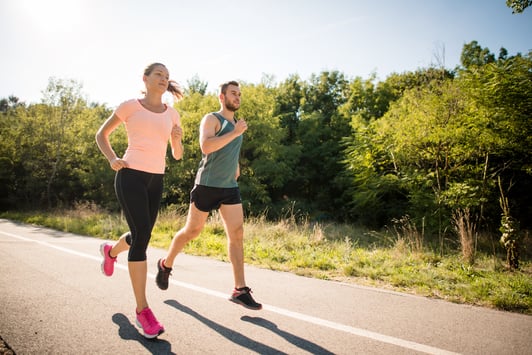 It seems that running injuries are all too common. There have been many research studies done on runners and, each year, as many as 79% of runners are sidelined due to injuries. Here are 5 ways to avoid injuries when running.
It seems that running injuries are all too common. There have been many research studies done on runners and, each year, as many as 79% of runners are sidelined due to injuries. Here are 5 ways to avoid injuries when running.
1. Add Strength Training
Strong muscles, ligaments, and tendons can guard against the impact of running, lead to improved running form, and help you achieve a more consistent gait. When the body is strong, the brain is able to tell the muscles to brace for impact before your foot even hits the ground. The glutes and the core contract, in order to, steady the pelvis and the leg. The foot and ankle muscles are activated, providing a solid foundation for your heel strike. Many runners lack strength in at least one muscle group. When one stabilizer muscle is weak, the other muscles make accommodations for the weakness and therefore can become overworked. This can create a “domino effect” in the body and cause an injury or injuries.
2. Always Warm-Up AND Cool Down
A warm-up prepares the body for exercise, by increasing the heart rate and blood flow to the muscles. Then, just as the warm-up prepares the body, the cool down brings it back to its normal state. The time spent warming up and cooling down helps prevent muscle soreness and aids in recovery, both of which will help prepare the body for your next run.
3. Use Correct Form
There are many disagreements amongst runners about what defines correct running form. Just as baseball players swing a bat, or a guitarist plays a guitar, there may be some variance in form from runner to runner. But, there is some common ground, and most can agree that certain components of form, such as, good posture and proper stride, can help prevent injury. For proper posture: Be sure to keep the upper torso straight and the head directly over the shoulders. DO NOT arch the lower back. For proper stride: Avoid over-striding, which is when the foot lands well ahead of the knee. Overstriding can put extra wear and tear on the muscles and joints. Try to focus on where your foot is landing and place it close to the body. Instead of reaching with the foot, try to drive forward with the knee.
4. Wear Proper Footwear
Shoes can alter your running form and have an impact on the amount of force that is applied to the joints with each step. Professional running stores may be a good place to start when trying to find the right shoe for you, but the best indication is how the shoe feels. If it doesn’t feel good, then it’s putting stress somewhere. If you experience aches and pains after a run, it may be a good indication that you’re not in the right shoe. You may need to try a few pairs before you find the right shoe for you. Also, be sure to change your shoes often. Running shoe should be replaced every 350-450 miles.
5. Avoid the terrible "too's"
Don't do too much, too soon, too often, too fast, too hard, with too little rest. Listen to your body and ease into it and rest when needed.

